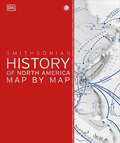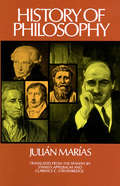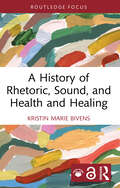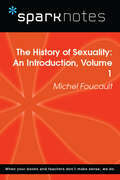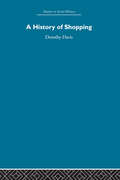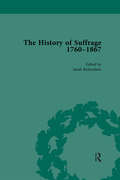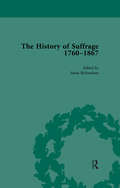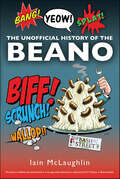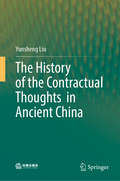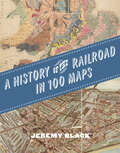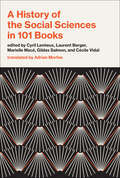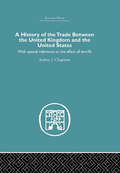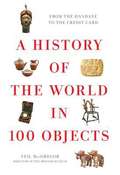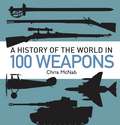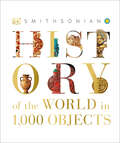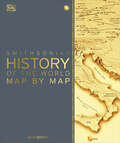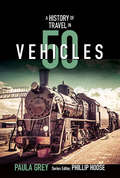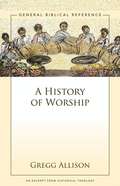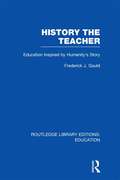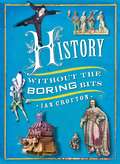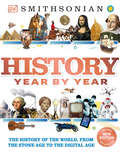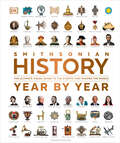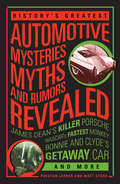- Table View
- List View
History of North America Map by Map (DK History Map by Map)
by DKA visual journey through the history of North America via a series of engaging, detailed maps, explaining key events and eras from prehistory to the 21st century.Specially created maps tell the story of this vast region: the first human populations and the lands of indigenous peoples; the complex ancient civilizations that arose in Mexico; the first Westerners to arrive on the shores, from the Vikings to the Mayflower; early settlements and the devastating consequences for the indigenous population; the stories of enslaved people and the abolition of slavery; the American Revolution and Civil War that shaped the modern United States; the Mexican-American War; the founding of Canada; and the industrial era and the growth of a global superpower. Brand new maps are accompanied by historic maps, documents, and artefacts, while timelines clearly lay out the chronology of events. Each era is introduced and explained, while features offer a closer look at selected moments. Whether for casual browsing or a deep dive into the past, History of North America Map by Map is essential reading for anyone who wants to know more about this fascinating land.
History of Philosophy
by Julian MariasThorough and lucid survey of Western philosophy from pre-Socratics to mid 20th century: major figures, currents, trends, literature, significance, and more. Valuable section on contemporary philosophy -- Brentano, Ortega, Heidegger, others. One of the best elementary history of philosophy available. "Brevity and clarity of exposition..." -- Ethics.
A History of Rhetoric, Sound, and Health and Healing (Routledge Studies in Rhetoric and Communication)
by Kristin Marie BivensA History of Rhetoric, Sound, and Health and Healing argues for medico-sonic knowledge — systematically interpreted bodily sounds with medical knowledge mediated by rhetoric — as an evolving corporeal practice with an incomparable, sprawling history.Taking a materialist-feminist perspective, the book rhetorically accounts for sound and suggests rhetoric enables bodily sounds as understandable, knowable, and treatable with power to help and discipline bodies in health, healing, and hospital contexts. From an expansive, pan-historiographic approach integrated with and influenced by fieldwork from neonatal intensive care units (NICUs) in Denmark and the United States, the author explores intentional and unintentional diagnostic, prognostic, and therapeutic uses of sound in contemporary Western biomedical health systems and promotes a new research concept and fieldwork practice, sound in all research.The insightful, timely volume will interest students and researchers in the medical humanities, rhetoric and communication, health communication, sound studies, medical and allied health sciences, and research methods.
The History of Sexuality: An Introduction, Volume 1 (SparkNotes Philosophy Guide)
by SparkNotesThe History of Sexuality: An Introduction, Volume 1 (SparkNotes Philosophy Guide) Making the reading experience fun! SparkNotes Philosophy Guides are one-stop guides to the great works of philosophy–masterpieces that stand at the foundations of Western thought. Inside each Philosophy Guide you&’ll find insightful overviews of great philosophical works of the Western world.
A History of Shopping
by Dorothy DavisFirst published in 2006. This study looks at eight centuries retail trading and shopping to answer the question of how people did tehir shopping in the past in England.
The History of Suffrage, 1760-1867 Vol 3
by Anna Clark Sarah RichardsonThis work brings together key texts drawn from the history of suffrage advocacy and agitation. The whole issue of voting rights and representation is shown to be anchored firmly in the wider political culture of Britain and Ireland as well as the Empire as a whole. Volume 3 covers texts from 1731 to 1832.
The History of Suffrage, 1760-1867 Vol 4
by Anna Clark Sarah RichardsonThis work brings together key texts drawn from the history of suffrage advocacy and agitation. The whole issue of voting rights and representation is shown to be anchored firmly in the wider political culture of Britain and Ireland as well as the Empire as a whole. Volume 4 covers texts from 1839 to 1859.
The History of the Beano
by Iain McLaughlinThe Beano is Britain's longest-running and best-loved comic. Since 1938 it has brought thrills and laughter to generation after generation of children, seeing the young and young-at-heart through World War 2, the social changes of the 1950s and 60s and on into a new millennium. How has the comic evolved since its early days? How many of the classic characters and their stories do you remember? What are the important changes that have happened through the years, why have they happened and why has The Beano survived when all the other comics have folded? Every child in the UK since the 1950s has known Dennis the Menace, the Bash Street Kids, Minnie the Minx and Roger the Dodger, but how many know the writers and artists who created these iconic comic characters? How do they write the scripts week after week? Where did the inspiration come from? How did the artists come to work for this Great British institution? This is the story of the Beano Comic, told in the words of the people who made it, going back to the dark, harsh days of the 1930s and continuing through to the present day. A unique insight into the country’s most beloved comic.
The History of the Contractual Thoughts in Ancient China
by Yunsheng LiuThis book explores the intellectual history of contract law in ancient China by employing archaeological and empirical methodologies. Divided into five chapters, it begins by reviewing the origin of the contract in ancient China, and analyzing its name, primary form, historical premise and functions. The second chapter discusses free will and lawfulness in the establishment of a contract, offering insights into the impact of contracts on social justice. In turn, the third chapter addresses the inner core of the contract: validity and liability. This allows readers at all levels to identify the similarities and differences between contracts from different eras and different parts of the world, which will also benefit those pursuing comparative research in related fields. Chapters four and five offer a philosophical exploration of contract history in ancient China, and analyze key aspects including human nature and ethical justice.
History of the Labor Movement in the United States, Vol. II: From the Founding of the American Federation of Labor to the Emergence of American Imperialism
by Philip S. FonerThis work includes information about: '80s Socialist movement and Labor, the Knights of Labor, Haymarket and May Day, Labor political action, the rise of the AFL, the Homestead strike, Coal creek and Cour d'Alene, American Railway Union, Pullman strike, Labor populism, Labor and the Spanish-American War, Labor and imperialism, and more.
History of the Labor Movement in the United States, Vol. III: The Policies and Practices of the American Federation of Labor, 1900-1909
by Philip S. FonerLabor at the turn of the Century; Open-shop drive; National Civic Federation; The church and labor; business unionism; Craft vs industrial unions; Women, Black and immigrant workers; AFL political policies; the Socialists; Western Federation of Miners; the American Labor Union, more.
A History of the Railroad in 100 Maps
by Jeremy BlackThe first international history of railroads and railroad infrastructure told through stunningly reproduced maps. Since their origins in eighteenth-century England, railroads have spread across the globe, changing everything in their path, from where and how people grew and made things to where and how they lived and moved. Railroads rewrote not only world geography but also the history of maps and mapping. Today, the needs of train companies and their users continue to shape the maps we consume and consult. Featuring full-color maps primarily from the British Library's distinguished collection—many of them never before published—A History of the Railroad in 100 Maps is the first international history of railroads and railroad infrastructure told through maps. Jeremy Black includes examples from six continents, spanning a variety of uses from railroad planning and operations to guides for passengers, shippers, and tourists. Arranged chronologically, the maps are accompanied by explanatory text that sheds light on the political, military, and urban development histories associated with the spread of railroads. A final chapter considers railroad maps from games, books, and other cultural artifacts. For anyone interested in the history of railroads or maps, A History of the Railroad in 100 Maps will offer new and unexpected insights into their intertwined global history.
A History of the Social Sciences in 101 Books
by Cyril Lemieux Laurent Berger Marielle Macé Gildas Salmon Cécile VidalAn intellectual history of the social sciences that offers a library of 101 books that broke new ground for the field.What are the social sciences? What unifies them? This essay collection seeks to answer these and other important questions as it considers how the field has developed over the years, from post–World War II to the present day throughout the world. Edited by Cyril Lemieux, Laurent Berger, Marielle Macé, Gildas Salmon, and Cécile Vidal, A History of the Social Sciences in 101 Books brings together a diverse range of researchers in the social sciences to present short essays on 101 books—both renowned and lesser known—that have shaped the field, from Theodor Adorno and Max Horkheimer&’s Dialectic of Enlightenment (1947) to Michel Aglietta&’s Money: 5000 Years of Debt and Power (2016).While there have been surveys and intellectual histories of particular disciplines within the social sciences (history, anthropology, sociology), until now there has been no intellectual history of the social sciences as a unified whole. Far from presenting a fixed and frozen canon, A History of the Social Sciences in 101 Books offers instead a moving, multiform landscape with no settled questions, only an ongoing series of new perspectives and challenges to previously established grounding.
History of the Trade Between the United Kingdom and the United States: With Special Reference to the Effects of Tarriffs
by Sydney J. ChapmanFirst published in 2005. Routledge is an imprint of Taylor & Francis, an informa company.
A History of the World in 100 Objects
by Neil MacgregorThe blockbuster New York Times bestseller and the companion volume to the wildly popular radio seriesNeil MacGregor has blazed an unusual path to international renown. As director of the British Museum, he organized an exhibit that aimed to tell the history of humanity through the stories of one hundred objects made, used, venerated, or discarded by man. The exhibit and its accompanying BBC radio series broke broadcasting records and MacGregor's book became a bestselling sensation on both sides of the Atlantic and a huge Christmas hit, with more than 100,000 copies in print in the United States alone.Examining items from a chopping tool from Africa's Olduvai Gorge to the credit card, A History of the World in 100 Objects is an engrossing and profoundly original work of history that will captivate readers for many years to come.
A History of the World in 100 Weapons
by Chris McnabIt's a truism to say that history is written by the winners. But what is it about the winners that make them so powerful? In this enlightening new book, Chris McNab searches for answers to this question and much more, telling the story of the history of the world through the lens of the weapons used over time.Arranged by age, McNab details 100 weapons of history in a highly-illustrated format. Among these 100 weapons: * Roman gladius that helped establish the Roman Empire * Japanese Katana, or Samurai sword * English longbow, used to defeat the French at the battle of Agincourt * Maxim gun * Flying Fortress of World War II - the epitome of US military superiority * bomb on Hiroshima that made a weapon the ultimate deterrent * AK-47 rifle.A History of the World in 100 Weapons presents each weapon in full detail, exploring the how and why of the weapon's development, the times from which it emerged, how it was used in battle and by whom, and to what extent and impact. details of how and why each weapon was invented, the times they emerged from, how they were used in battle.Drawing on stories of famous battles, wars and leaders associated with each weapon, McNab presents a vivid history of the weapons themselves and their context in the development of world history.
History of the World in 1000 Objects
by DKDiscover how humans created their world from the objects they left behind - from the US Constitution to the first iPhone - in DK's latest history book.From the beginning of human history, the one thing that has defined us is our talent for making things, from basic technology and everyday objects, such as bowls and hand axes, to high-tech inventions, such as supersonic aircraft, smart devices, and Mars rovers.Objects speak volumes about a civilization, telling us how our ancestors lived - as well as what they believed in and valued. A bronze cat mummy shows us how highly the ancient Egyptians valued their feline companions, while a mechanical tiger toy tells the story of rising tensions between an Indian sultan and European colonizers. With stunning, exclusive photography, History of the World in 1000 Objects shows you the objects that our ancestors treasured - from the jewelry worn by the Mesopotamians to the prized ritual vessels used by the people of the Shang Dynasty - and gives you insight into what gave each culture its own identity. From astrolabes and airplanes to vacuum cleaners and X-rays, DK uses its hallmark visual style to weave the extraordinary legacy of our creativity into a unique view of world history that will change the way you see the objects all around us.
History of the World Map by Map (DK History Map by Map)
by DKExplore the history of the world in unprecedented detail with this ultimate guide to history throughout the ages. Maps don't just show us where to go, but also where we've been. If you're interested in finding out more about the biggest events in world history, then this book all about history of the world is perfect for you!This stunning history book for adults starts with the evolution and migration of our oldest ancestors out of Africa. You can then look up maps about the Greece and Persian War, the Mongol Conquests, Medieval Europe's trade routes, and the rise of the Ottomans. Explore maps about the colonisation of North America, the scientific revolution, Napoleon's advances, and Britain's control of India. Then uncover the history of later centuries, such as the Age of Imperialism, the American Civil War, industrialised Europe and the transformation of Japan.Journey into past like never before as you uncover:- Easy-to-read text panels for a deeper understanding of history- A total of 140 maps alongside stunning pictures and informative timelines- Storytelling maps to bring history to life- Published in association with the Smithsonian Institution in the USA.Bursting with striking illustrations and full of fascinating detail, this history book is the ultimate gift for map lovers, history enthusiasts of all ages and those who enjoy visiting museums and other historical sites, whether as a present for dad, or handy reference guide for any other history lover in your life! History of the World Map by Map aims to help you gain a strong understanding of some of the forces and movements across continents that have shaped our world!Go on guided tour through time and explore:- Prehistory 7 MYA-3000 BCE- The Ancient World 3000 BCE - 500 CE- Middle Ages 500-1450 CE- The Early Modern World 1450-1700- Revolution and Industry 1700-1850- Progress and Empire 1850-1914- The Modern World 1914-PresentAt DK, we believe in the power of discovery.So why stop there? The Map by Map series includes other titles such as History of the World Map by Map and World War II Map by Map, each detailing historical events and placing them in the context of geography. DK's luxurious Map by Map books are fantastic history gifts, packed with fascinating facts, high-quality photography, and detailed profiles and descriptions of people and events.
A History of Travel in 50 Vehicles (History in #50)
by Paula Grey Phillip HoosePaula Grey explores how creative thinkers--collaborating or competing and always building on the work of their predecessors--have envisioned new ways to move about in the world. The story of travel is the human story. From the first migrations out of Africa on weary feet to horses, camels, rafts, chariots, steamships, trains, hot air balloons, cars, submarines, and moon rockets, humans have combined imagination, daring, and technical brilliance to create new vehicles and improve existing ones. Geography and culture have influenced the development of vehicles in far-flung parts of the world, and human travel has, in turn, exerted a profound influence on society and the environment. Whether escaping deprivation, pestilence, persecution, oppression, or fear--or seeking abundance, freedom, fame, fortune, or a fresh start--we have always been a traveling species, and it seems we always will be. Here is the story of humankind's restless impulse to see what's over the next ridge, beyond the next sunrise, on the next planet. Enjoy the journey!
A History of Worship: A Zondervan Digital Short
by Gregg AllisonDerived from Gregg Allison’s magisterial Historical Theology, this digital resource provides a concise overview of Christian worship as it developed throughout the church’s history. Liturgy, sacraments, the regulative principle, the theology of worship, elements of worship—all of these and more are covered in this concise history. Readers wanting a handy reference resource to the full story of Christian worship from beginning to end will appreciate Allison’s careful and fair-minded overview.
History The Teacher: Education Inspired by Humanity's Story (Routledge Library Editions: Education)
by Frederick J GouldOrganized chronologically this volume examines education in England in the early twentieth century by discussing education through the ages, from pre-history to 1919. The author’s proposals were radical at the time of original education, although they embrace concepts which are now taken for granted in schools: that education of the "whole person" is vital; that the arts should enjoy equal prominence with the sciences; that schools are communities and that the educational experience will be richer for individuals if they work as and for a community.
History Without the Boring Bits
by Ian CroftonConventional chronologies of world history concentrate on the reigns of kings and queens, the dates of battles and treaties, the publication dates of great books, the completion of famous buildings, the deaths of iconic figures, and the years of major discoveries. But there are other more interesting stories to tell--stories that don't usually get into the history books, but which can nevertheless bring the past vividly and excitingly to life.Imagine a history lesson that spares you the details of such seminal events as the 11th-century papal-imperial conflict, that fails to say much at all about the 1815 Congress of Vienna--and that neglects entirely to mention the world-changing moment that was the 1521 Diet of Worms. Imagine instead a book that tells you the date of the ancient Roman law that made it legal to break wind at banquets; the name of the defunct medieval pope whose putrefying corpse was subjected to the humiliation of a trial before a court of law; the identity of the priapic monarch who sired more bastards than any other king of England; and last but not least the date of the demise in London of the first goat to have circumnavigated the globe twice. Imagine a book crammed with such deliciously disposable information, and you have History without the Boring Bits.By turns bizarre, surprising, trivial, and enlightening, History without the Boring Bits offers rich pickings for the browser, and entertainment and inspiration aplenty for those who have grown weary of more conventional works of history.
History Year by Year: The History of the World, from the Stone Age to the Digital Age (DK Children's Year by Year)
by DKGet to grips with history like never before as you travel through the ages in this history encyclopedia for children that stretches from prehistoric times to modern day. Introducing an updated volume of History Year by Year - a timeline of world history that joins the dots of history by putting key historic events across the world on one timeline for children, including everything from prehistoric people, to world wars, humans on the moon, and so much more! Every page is jam-packed pictures and original artefacts, to give children an accurate insight into each era. Including features that explain major events, such as the rise of the Roman Empire of the fall of Communism, in an accessible and easy-to-read manner that doesn&’t talk down to them. DK&’s History Year by Year shows the influences, patterns, and connections between the events that have shaped our world and reveal the history of the world as never before, making this history book for kids an educational must-have volume for children aged 9-12 with a thirst for knowledge, and interest in discovering more about world history. Celebrate your child&’s curiosity as they explore:- Over 1500 images that beautifully illustrates world history for children- Feature spreads look in detail at big themes and stories, such as the Renaissance and the French Revolution, and also include a timeline of events.- &“Child of the Time&” spreads explore the lives of children in history at very different periods, including Ancient Egypt, the Middle Ages, the Industrial Revolution, and World War II.- &“Moment in time&” spreads use one stunning, full-bleed image to capture one moment in history.- Updated timeline spanning prehistoric times up until 2018 Written with kids ages 9 to 12 in mind, this book uses unpretentious language and gives straightforward fun facts. The "Child Of The Time" feature encourages young people to imagine themselves in the past and lets them know that children had a place in history. Older readers will love this engaging educational book too! Dive in and explore the parts of the past you haven't yet discovered. The multitude of photos, maps and graphics make reading about history simple and enjoyable. This visual guide on history for kids provides the reader with an overview of the most fascinating events in history, with concise and bite-sized information. Authorised by the Smithsonian Institution, and featuring an updated timeline documenting recent events in world history that you may still remember happening, there truly is something for every kid to explore, learn and discover.
History Year by Year
by DKGet to grips with history like never before as you travel through the ages in this history encyclopedia for children that stretches from prehistoric times to modern day. Introducing an updated volume of History Year by Year - a timeline of world history that joins the dots of history by putting key historic events across the world on one timeline for children, including everything from prehistoric people, to world wars, humans on the moon, and so much more! Every page is jam-packed pictures and original artefacts, to give children an accurate insight into each era. Including features that explain major events, such as the rise of the Roman Empire of the fall of Communism, in an accessible and easy-to-read manner that doesn&’t talk down to them. DK&’s History Year by Year shows the influences, patterns, and connections between the events that have shaped our world and reveal the history of the world as never before, making this history book for kids an educational must-have volume for children aged 9-12 with a thirst for knowledge, and interest in discovering more about world history. Celebrate your child&’s curiosity as they explore:- Over 1500 images that beautifully illustrates world history for children- Feature spreads look in detail at big themes and stories, such as the Renaissance and the French Revolution, and also include a timeline of events.- &“Child of the Time&” spreads explore the lives of children in history at very different periods, including Ancient Egypt, the Middle Ages, the Industrial Revolution, and World War II.- &“Moment in time&” spreads use one stunning, full-bleed image to capture one moment in history.- Updated timeline spanning prehistoric times up until 2018 Written with kids ages 9 to 12 in mind, this book uses unpretentious language and gives straightforward fun facts. The "Child Of The Time" feature encourages young people to imagine themselves in the past and lets them know that children had a place in history. Older readers will love this engaging educational book too! Dive in and explore the parts of the past you haven't yet discovered. The multitude of photos, maps and graphics make reading about history simple and enjoyable. This visual guide on history for kids provides the reader with an overview of the most fascinating events in history, with concise and bite-sized information. Authorised by the Smithsonian Institution, and featuring an updated timeline documenting recent events in world history that you may still remember happening, there truly is something for every kid to explore, learn and discover.
History's Greatest Automotive Mysteries, Myths and Rumors Revealed: James Dean's Killer Porsche, NASCAR's Fastest Monkey, Bonnie and Clyde's Getaway Car, and More
by Matt Stone Preston Lerner"Chock-full of amusing car-related trivia and miscellany." —Detroit NewsDid you know that after James Dean's death behind the wheel of his Porsche 550 Spyder, parts of the car were sold off, and said parts then cursed their new owners? (Or did they?) Did you know Bonnie and Clyde stole Ford V-8s almost exclusively as getaway cars because they were the fastest cars of their day—and that Clyde wrote Henry Ford a thank-you note? Did you know that a monkey by the name of Jocko Flocko once won a Grand National race? (NASCAR Hall of Fame driver Tim Flock helped.) Rumors, myths, and fantastic stories have swirled around the automobile for over a century. This fascinating collection compiles funny stories and a trunkful of trivia: What was the first car to break the sound barrier? Who won the first Indy 500? What kind of car was dancer Isadora Duncan in when she was killed? What car performed the most spectacular stunt in the James Bond movie oeuvre? In all of these cases, the answers may not be what you think."Entertaining stories of vehicular crime, racing, moviemaking and various mishaps and mayhem." —The New York Times
